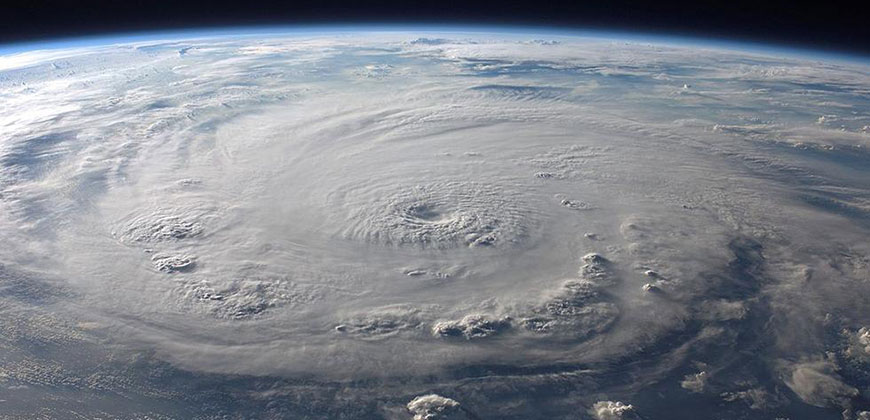The 2016 Atlantic hurricane season forecast released Thursday from Colorado State University calls for the number of named storms and hurricanes to be near historical averages.
A total of 12 named storms, five hurricanes and two major hurricane are expected this season, according to the forecast prepared by CSU, which is headed by Dr. Phil Klotzbach in consultation with long-time hurricane expert Dr. William Gray.
Learn more at https://weather.com/storms/hurricane/news/2016-hurricane-season-forecast-atlantic-colorado-state-csu
This is close to the 30-year average of 12 named storms, six hurricanes and three major hurricanes. A major hurricane is one that is Category 3 or stronger on the
Saffir-Simpson Hurricane Wind Scale.
Numbers of Atlantic Basin named storms, those that attain at least tropical storm strength, hurricanes, and hurricanes of Category 3 intensity forecast by The Weather Company and Colorado State University compared to the 30-year average.
Those seasonal forecast numbers do not include Hurricane Alex, a rare January hurricane that struck the Azores a few months back. Though the official hurricane season spans the months from June through November, occasionally we can see storms form outside those months.
(MORE: Hurricane Alex Recap)
The CSU outlook is based on a combination of 29 years of statistical predictors, combined with analog seasons exhibiting similar features of sea-level pressure and sea-surface temperatures in the Atlantic and eastern Pacific Oceans.
Here are three questions about this outlook and what it means for you.
Q: What Does This Forecast Mean For the U.S.?
There is no strong correlation between the number of storms or hurricanes and U.S. landfalls in any given season. One or more of the 12 named storms forecast to develop this season could hit the U.S., or none at all. Therefore, residents of the coastal United States should prepare each year no matter the forecast.
A couple of classic examples of why you need to be prepared each year occurred in 1992 and 1983.
The 1992 season produced only six named storms and one subtropical storm. However, one of those named storms was Hurricane Andrew, which devastated South Florida as a Category 5 hurricane.
In 1983 there were only four named storms, but one of them was Alicia. The Category 3 hurricane hit the Houston-Galveston area and caused almost as many direct fatalities there as Andrew did in South Florida.
In contrast, the 2010 season was active. There were 19 named storms and 12 hurricanes that formed in the Atlantic Basin.
Despite the large number of storms that year, not a single hurricane and only one tropical storm made landfall in the United States.
In other words, a season can deliver many storms, but have little impact, or deliver few storms and have one or more hitting the U.S. coast with major impact.
The U.S. averages between 1 to 2 hurricane landfalls each season, according to NOAA’s Hurricane Research Division statistics. However, the number of U.S. landfalls has been much below average in the last decade.
The current 10-year running total (2006-2015) of U.S. hurricane landfalls is seven, according to Alex Lamers, a meteorologist with The National Weather Service. This is a record low for any 10-year period dating to 1850, and is considerably lower than the average of 17 per 10-year period dating to 1850, Lamers added.
(MORE: Hurricane Central)
U.S. hurricane landfalls the last 10 years. Note: Sandy in 2012 is not shown since it officially made landfall as a non-tropical cyclone.
Of course, the record-breaking 2005 hurricane season is now outside that current 10-year running total. 2005 was also the last season we saw a Category 3 or stronger hurricane (Wilma) hit the U.S., the longest such streak dating to the mid-19th century.
(MORE: Florida Hurricane Drought Continues)
Bottom line: The U.S. is due for another hurricane strike sooner rather than later, but it’s impossible to know if that will occur this season. Keep in mind, however, that even a weak tropical storm hitting the U.S. can cause major impacts, particularly if it moves slowly, resulting in flooding rainfall.
Q: Will El Niño or La Niña play a role?
The strong El Niño we saw this winter continues to fade away and may transition to its counterpart La Niña by this fall. Of course, if this handoff from El Niño to La Niña conditions occurs, it could happen during the middle of the 2016 hurricane season.
Klotzbach said that the transition from El Niño to neutral or La Niña conditions during the 2016 hurricane season makes this particular April hurricane outlook very uncertain.
Using the El Niño intensity classification scheme from consultant meteorologist Jan Null, we examined five previous hurricane seasons following strong El Niños. The statistics from each of those seasons is below.
|
Named Storms |
Hurricanes |
Cat. 3+ Hurricanes |
U.S. Hurricane Landfalls |
| 1998 |
14 |
10 |
3 |
3 |
| 1983 |
4 |
3 |
1 |
1 |
| 1973 |
8 |
4 |
1 |
0 |
| 1966 |
11 |
7 |
3 |
2 |
| 1958 |
10 |
7 |
5 |
0 |
As you can see, there’s quite a spread, ranging from a record low four named storms in 1983 to 14 such storms in 1998.
The 1998 season featured seven U.S. landfalling tropical cyclones, three of which – Bonnie, Earl, and Georges – were hurricanes at landfall.
Despite only four named storms in 1983, two of those made U.S. landfall, including Category 3 Hurricane Alicia in southeast Texas.
This again illustrates the poor correlation between the number of named storms or hurricanes and landfalls.
In all, there have been a total of six U.S. hurricane landfalls in the five post-strong El Niño seasons dating to 1958, for an average of roughly one a season. Two of those five seasons were without a U.S. hurricane landfall, however.
Klotzbach found that the chance of a U.S. hurricane impact rises dramatically in a La Niña or neutral (neither El Niño or La Niña) season compared to an El Niño season.
Without El Niño contributing to stronger wind shear and dry air in the Caribbean Sea like we saw in 2015, it at least loads the dice toward an increased chance of tropical cyclones surviving into the Caribbean Sea, or forming there in 2016, particularly later in the season as El Niño disappears farther in the rear-view mirror.
Q: What Other Factors Are in Play?
The three previous Atlantic hurricane seasons featured either few named storms (2014; 8) or a greater number of storms, but few of which survived long or became hurricanes (2013 and 2015).
2013 and 2014 featured prohibitive dry air and/or wind shear during a significant part of the season, but El Niño was nowhere to be found.
In 2015, El Niño likely played a significant suppressing role in the 2015 Atlantic hurricane season. Klotzbach found that June through October 2015 Caribbean wind shear was the highest on record dating to 1979. Klotzbach also said the magnitude of dry air over the Caribbean Sea in the peak season month of August and September also set a record.
2015 Atlantic Tropical Cyclone Tracks
As you can see, dry air and wind shear can detrimental to tropical storm or hurricane development no matter whether El Niño is present or not. This is one factor to watch for in the 2016 season.
Klotzbach said that wind shear enhanced by El Niño is likely to dissipate the next several months. However, he added that the northern Atlantic Ocean has water temperatures that are colder than average which can cause atmospheric conditions to be unfavorable for the development and strengthening of Atlantic hurricanes.
MORE ON WEATHER.COM: H














